![]()
![]()
![]()
Use LEFT and RIGHT arrow keys to navigate between flashcards;
Use UP and DOWN arrow keys to flip the card;
H to show hint;
A reads text to speech;
48 Cards in this Set
- Front
- Back
|
Root System |
The ability to acquire resources efficiently is traceable to the evolution of three basic organs-roots, stems, and leaves. These organs form a root system and a shoot system., the latter consisting of stems and leaves. |
|
|
Roots |
An organ that anchors a vascular plant in the soil, absorbs minerals and water, and often stores carbohydrates. Roots are typically not photosynthetic they starve unless photosynthates, the sugars and carbohydrates produced during photosynthesis are imported from the shoot system. conversely , the shoot system depends on the water and minerals that roots absorb from the soil. |
|
|
Stems |
An organ that raises or separates leaves exposing them to sunlight. Stems also raise reproductive structures, facilitating dispersal of pollen and fruit. |
|
|
Leaves |
In most vascular plants the leaf is the main photosynthetic organ, although green stems also perform photosynthesis. Leaves generally consist of a flattened blade and stalk. |
|
|
Dermal Tissue System |
-Plant's outer protective covering like skin Defense against physical damage and pathogens In non woody plants it is usually a single tissue called the epidermis, a layer of tightly packed cells -In stems and leaves the cuticle is a waxy coating on the epidermal surface, it helps prevent water loss |
|
|
Vascular Tissue System |
Carries out long distance transport of materials between the root and shoot systems Xylem and Phloem |
|
|
Xylem |
Conducts water and dissolved minerals upward from roots into the shoots |
|
|
Phloem |
Transports sugars, the products of photosynthesis, from where they are made. |
|
|
Ground Tissue System |
Internal to the vascular tissue is known as pith. External to the vascular tissue is called cortex. Is not just a filler. Includes various cells specialized for functions such as storage, photosynthesis and support. |
|
|
Parenchyma Cells |
form the "filler" tissue in the soft parts of plants |
|
|
Collenchyma Cells |
Have thin primary walls with some areas of secondary thickening Provides extra structural support, particularly in regions of new growth |
|
|
Sclerenchyma Cells |
Have thick lignified secondary walls and often die when mature |
|
|
Structures of Parenchyma Cells Collenchyma Cells Sclerenchyma Cells |

|
|
|
Structure of Xylem and Phloem |

|
|
|
Form and function of apical and lateral meristems |
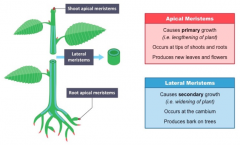
|
|
|
Root Growth |
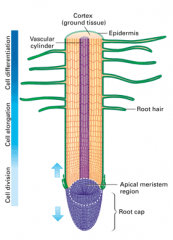
|
|
|
Shoot Growth |
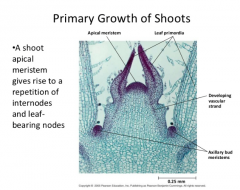
|
|
|
Describe the structure of leaves |
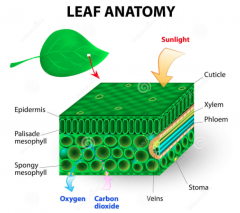
|
|
|
Describe briefly how secondary growth occurs. |
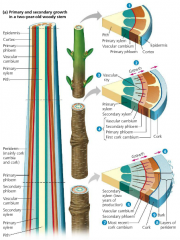
The growth in thickness produced by lateral meristems occurs in stems and roots of woody plants, but rarely in leaves. Secondary growth consists of the tissues produced by the vascular cambium and cork cambium. |
|
|
Organ (Plant) |
a specialized center of body function composed of several different types of tissues. |
|
|
Root system vs. Shoot system |
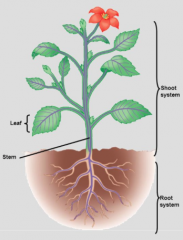
|
|
|
Nodes |
The points at which leaves are attached |
|
|
Internodes |
The segments between nodes |
|
|
Epidermis |
Skin Tissue of plant |
|
|
Cuticle |
Waxy skin covering often found on the epidermis, prevents drying out, and acts as waterproofing, and protection against microbial attack |
|
|
Periderm |
The periderm is the secondary protective (dermal) tissue that replaces the epidermis during growth in thickness of stems and roots of gymnosperms and dicotyledons (i.e., secondary growth) |
|
|
Stele |
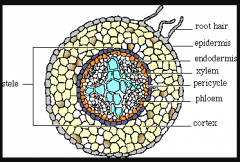
Vascular Cylinder appearing in the cross section as a lobed core of xylem with phloem between the lobes |
|
|
Pith |
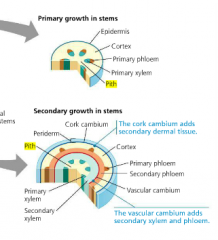
Soft spongy tissue in the very center of shoots and primary, secondary growths. Ground Tissue |
|
|
Cortex |
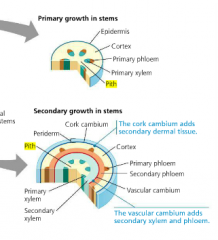
The outermost layer of the stem or root of a plant, bounded on the outside by the epidermis and on the inside by the endodermis. Ground Tissue |
|
|
Sclereids |
Cells that are specialized entirely for support and strengthening. They are boxier than fibers and irregular in shape. They have very thick lignified secondary walls. |
|
|
Fibers |
Cells that are specialized entirely for support and strengthening. Usually grouped in strands are long, slender, and tapered. Hemp fibers make ropes, flax fibers for weaving into linen.
|
|
|
Tracheids |
Water conducting cell, tubular. Occur in the Xylem of all vascular plants. |
|
|
vessel elements |
Water conducting cell, tubular. Occur in the Xylem of all vascular plants. Has perforations at the end plates which make them a tube-like long structure while tracheids do not have end plates. |
|
|
sieve-tube elements |
Chains of cells that transport nutrients throughout the phloem. |
|
|
sieve plates |
End walls between sieve-tube elements. They have spores that facilitate the flow of fluid from cell to cell along the sieve tube. |
|
|
companion cells |
Non conducting cells that follow along side the sieve-tube element. They are connected to the sieve tube element by numerous plasmodesmata. Aids in loading the sieve tube up with sugars. |
|
|
Indeterminate growth |
Growth that is not terminated. Unlike determinate growth that stops once a genetically pre-determined structure has completely formed. |
|
|
meristems |
The tissue in most plants containing undifferentiated cells (meristematic cells), found in zones of the plant where growth can take place. Meristematic cells give rise to various organs of the plant and keep the plant growing. |
|
|
Primary growth |
The increase in length of the shoot and the root. Vertical. |
|
|
secondary growth |
Results from cell division in the cambia or lateral meristems and that causes the stems and roots to thicken. Horizontal. |
|
|
vascular cambium |
A plant tissue located between the xylem and the phloem in the stems and roots of vascular plants. It is a cylinder of unspecialized meristem cells that divide to form secondary vascular tissues. |
|
|
cork cambium |
Tissue in the stem of a plant that gives rise to cork on its outer surface and a layer of cells containing chlorophyll on its inner surface. |
|
|
Root camp |
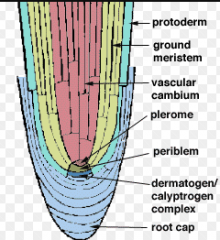
A section of tissue at the tip of a plant root. It is also called calyptra. |
|
|
leaf primordial |
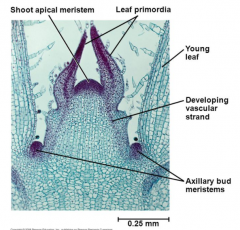
Where leaves develop from. |
|
|
apical dominance |
The phenomenon whereby the main, central stem of the plant is dominant over (i.e., grows more strongly than) other side stems; on a branch the main stem of the branch is further dominant over its own side branchlets. |
|
|
Stomata |
Spores that interrupt the epidermis which allow for gas exchange of CO2 and O2. |
|
|
guard cells |
Each of a pair of curved cells that surround a stoma, becoming larger or smaller according to the pressure within the cells. |
|
|
mesophyll |
Leaf's ground tissue, is sandwiched between the upper and lower epidermal layers. Specialized for photosynthesis. |

